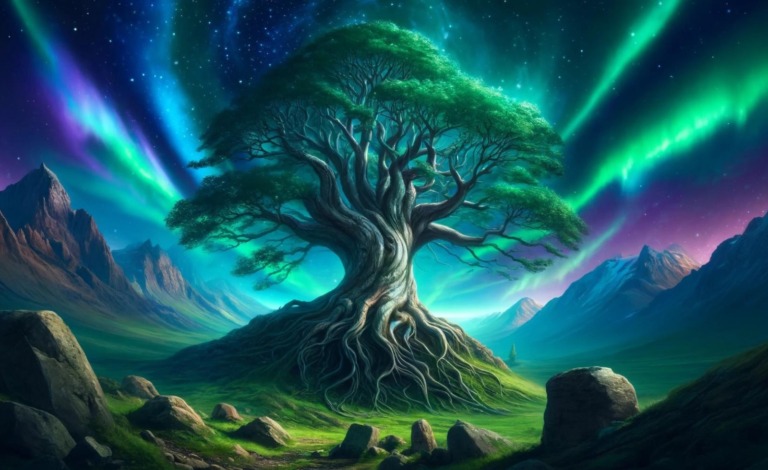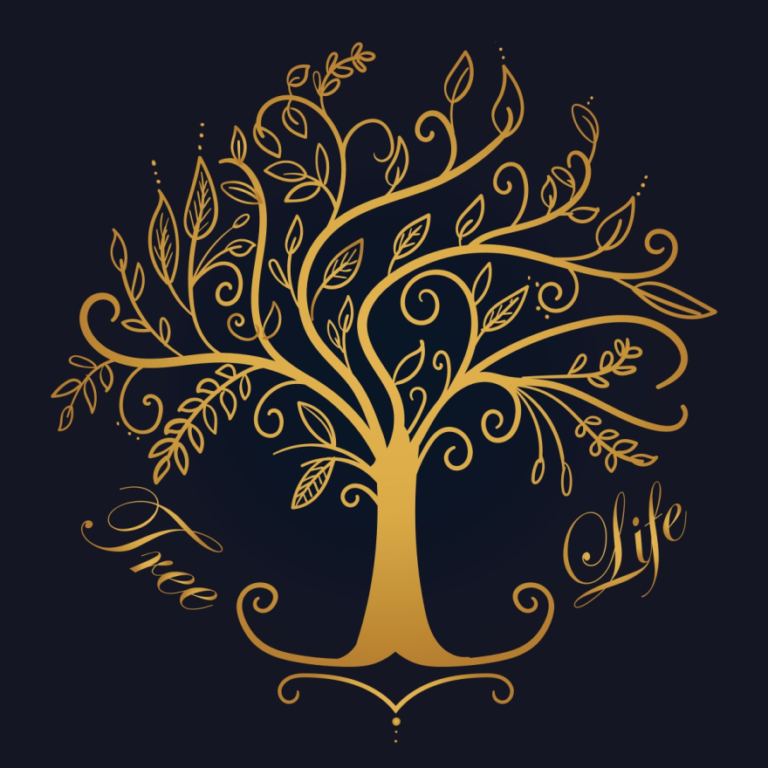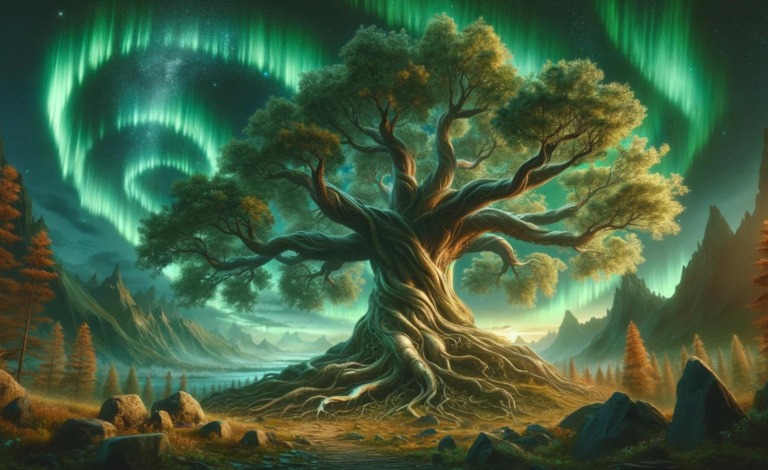In the rich world of Norse mythology, few symbols are as profound as Yggdrasil, the World Tree. Let’s take a closer look at its significance.
This immense and sacred ash tree stands at the very heart of the Norse cosmos, serving as the axis mundi—the central point around which all of existence revolves.
 An interpretation of Yggdrasil, the world tree.
An interpretation of Yggdrasil, the world tree.Yggdrasil's roots and branches extend into the various realms, embodying the interconnectedness of life, death, and rebirth.
Its significance is woven through the myths and sagas, reflecting the Norse understanding of the universe's structure and the delicate balance of cosmic forces
The Centre of the Cosmos
Yggdrasil's role as the centre of the cosmos is central to understanding its importance in Norse mythology. The tree connects the nine realms, each of which represents a different aspect of existence.
At its roots lie Niflheim, the realm of ice and cold, and Muspelheim, the land of fire, symbolizing the primordial forces that shape the world.
Midgard, the realm of humanity, is nestled among Yggdrasil's sturdy branches, while Asgard, the home of the gods, sits high above, accessible by the rainbow bridge Bifröst.
 Yggdrasil links the realms of Norse Mythology.
Yggdrasil links the realms of Norse Mythology.This interconnected structure reflects the Norse belief in the unity and interdependence of all things. Yggdrasil is a physical entity, yes. But, it is also a representation of the world's order and the cycles of life and death that sustain it.
The Roots of Existence
The roots of Yggdrasil are as significant as its towering branches, delving deep into the fabric of Norse cosmology.
The tree is nourished by three wells: Urdarbrunnr (the Well of Fate), Hvergelmir (the Roaring Kettle), and Mímisbrunnr (Mimir's Well). Each well holds profound importance in the mythology, linking Yggdrasil to the past, present, and future.
Urdarbrunnr, located in Asgard, is guarded by the Norns—Urd (the past), Verdandi (the present), and Skuld (the future). These three female beings weave the destinies of gods and men, their threads of fate symbolizing the inescapable nature of destiny.
Hvergelmir, in the icy realm of Niflheim, is the source of numerous rivers and the origin of life, while Mímisbrunnr, situated beneath one of Yggdrasil's roots in Jotunheim, is a well of wisdom.
Odin himself sacrificed an eye to drink from Mimir's Well, gaining profound knowledge and insight.
The Sustainer of Life
Yggdrasil is not merely a connector of realms but also a sustainer of life. The tree is inhabited by various creatures that symbolize different aspects of the Norse worldview.
 A different interpretation of Yggdrasil.
A different interpretation of Yggdrasil.Among its branches lives an eagle, embodying the sky and knowledge, while a squirrel named Ratatoskr scurries up and down, carrying messages and stirring strife between the eagle and the serpent Nidhogg that gnaws at Yggdrasil's roots.
This serpent, along with other beings that dwell in the roots, represents the forces of destruction and decay.
These creatures illustrate the dynamic balance of creation and destruction, growth and decay, that Yggdrasil embodies. The tree itself is a testament to the resilience of life, continually renewing and regenerating despite the constant threats to its existence.
Symbol of Wisdom and Sacrifice
Yggdrasil also symbolizes wisdom and sacrifice, themes central to many Norse myths.
Odin's self-sacrifice upon Yggdrasil is one of the most poignant stories associated with the tree. Seeking the knowledge of runes and deeper wisdom, Odin hung himself from the tree for nine days and nights, pierced by his spear.
This act of self-sacrifice underscores the Norse value placed on the pursuit of knowledge and the understanding that wisdom often comes at a great personal cost.
The Eternal Cycle
Yggdrasil is a living representation of the eternal cycle of life, death, and rebirth. The tree's health and vitality are crucial to the well-being of the cosmos.
During Ragnarok, the foretold end of the world, Yggdrasil will tremble, and its destruction will herald the collapse of the old order.
Yet, from this destruction, a new world will emerge, and Yggdrasil will be reborn, signifying renewal and the continuity of life.
In conclusion, Yggdrasil, the World Tree, stands as a powerful symbol in Norse mythology, embodying the universe's structure, the interconnectedness of all things, and the eternal cycles that govern existence.
Its roots, branches, and inhabitants reflect the Norse understanding of the world's complexity and the delicate balance that sustains it.
Through its myths and stories, Yggdrasil offers profound insights into the Norse worldview and the timeless themes of destiny, wisdom, and renewal.
The post The Significance of Yggdrasil, the World Tree of Norse Mythology appeared first on Life in Norway.

.png) 1 week ago
1 week ago
















 English (US) ·
English (US) ·